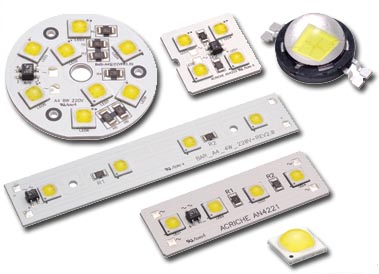Seoul Semiconductor Stresses Backlight Chip Sales In Taiwan and More
2009/10/07 | By Ken LiuWhile promoting its unique "Acriche" AC light emitting diode (AC LED) emitters to big-name lighting manufacturers globally, Seoul Semiconductor Co., Ltd. is scrambling for orders from Taiwanese liquid crystal display-panel (LCD-panel) makers looking for LED backlights.

"We believe notebook computers and LCD TVs, especially LCD TVs, will become the prime growth engines for the LED industry beginning the second half this year," comments Ken Hao, regional manager of Seoul Semiconductor's Taiwan office. Consequently, the Taiwan office, a unit of the chipmaker's LED packaging operation, projects revenue posting an annual 200% increase this year. "Globally, our packaging revenue is projected to rise 50% this year, to an equivalent of NT$15-20 billion (US$454-606 million at US$1:NT$33)," Hao reports.
Seoul Semiconductor specializes in blue chip as backlight and "Acriche" for lighting. Its packaging unit is authorized to use patents held by Cree and Nichia on white LEDs after signing cross-licensing agreement with the two LED chipmakers. According to Hao, Seoul's packaging unit has used many Cree and TG (Toyoda Gosei)chips into its packages for lighting.
Nichia, Cree, Osram and Philips Lumileds have been Seoul Semiconductor's archrivals in the LED segment. The licensing agreement, Hao stresses, keeps Seoul Semiconductor from infringing patents.
Lacking Patent Protection
"Taiwan's weakness in LED manufacturing is lacking patent protection, making it vulnerable to lawsuits," Hao notes. However, his company appreciates Taiwan's processing techniques, which have made the island's LED manufacturing competitive and attractive to contract buyers. "We've made Taiwan an important contract supplier by investing in epitaxy-wafer and lead-frame ventures on the island," Hao notes.
Hao thinks, with South Korean LCD TV makers LG and Samsung as its customers, partnership deals with Seoul Semiconductor has advantages to Taiwan's LED-backlight makers: patent protection and information on consumer preferences. He notes that LCD TVs usually requires more LED packages than notebook computers. "Now LED manufacturers globally are scrambling to expand capacities to meet huge demands, especially from LCD TV makers."
Hao notes that Taiwan and South Korea are currently the world's top-two suppliers of LCD panels, hence a hotbed to nurture their LED backlight industry. "LCD is a tough industry that requires big investment and economy of scale," he elaborates.
Acriche
In the lighting sector, the South Korean LED Company is known for its "Acriche", AC LED that can be plugged into household 110V and 220V outlets without using transformers. The basic model has a 2 and 4-watt LED.
"Ours is the world's first commercialized Acriche which is UL safety approved," Hao reports, adding that his company acquires CE and TUV certifications.
Acriche, emitter combines Seoul Semiconductor's blue chip and silicate-based phosphor powder to produce white light in most cases.
According to Hao, especially new product Acriche A4 produces 65~75 lumens per watt, and the company plans to improve the efficacy to 120 lumen/watt by end of 2010. Mostly used in indoor lights, the relatively expensive price prevents the Acriche from becoming popular among Taiwan's LED lighting manufacturers.
According to Eric Choi, sales manager of Seoul Semiconductor's Shenzhen office, when the Acriche A4's efficacy reaches 100 lumens per watt, it will replace DC devices and traditional lighting products.
Seoul Semiconductor plans to debut a 1W LED light soon, with the emitter to deliver color-rendering index (CRI) of 85, only 15 short of the ideal 100 achieved by daylight.
Higher Heat
Choi notes that due to structural factors, his company's Acriche produces more heat than a DC LED. "So, efficient thermal dissipation is especially important in the design of lighting when using such LED. We suggest our Acriche customers keep the PN junction temperature at 80C," he says. And the die is bundled on copper substrate for excellent thermal conductivity.
Assumed in 1992 from Chung Hoon Lee, CEO of Seoul Semiconductor, the company developed its "Acriche"technology in 2004. The company aims to use such patented technology to become the world's No.3 LED manufacture by 2011 with projected revenue of 1300 billion won, as well as motivate global users to adopt "Acriche",AC LED.
According to Choi, Seoul had global market share of 5.1% in 2007, up from 3.8% in 2006(Source: Strategies Unlimited, High-Brightness LED Market Review and Forecast-2008) "We were the only chipmaker to double market share in the 2006-2007 period. Lumiled stayed flat at 6.5% whereas the others lost shares."




